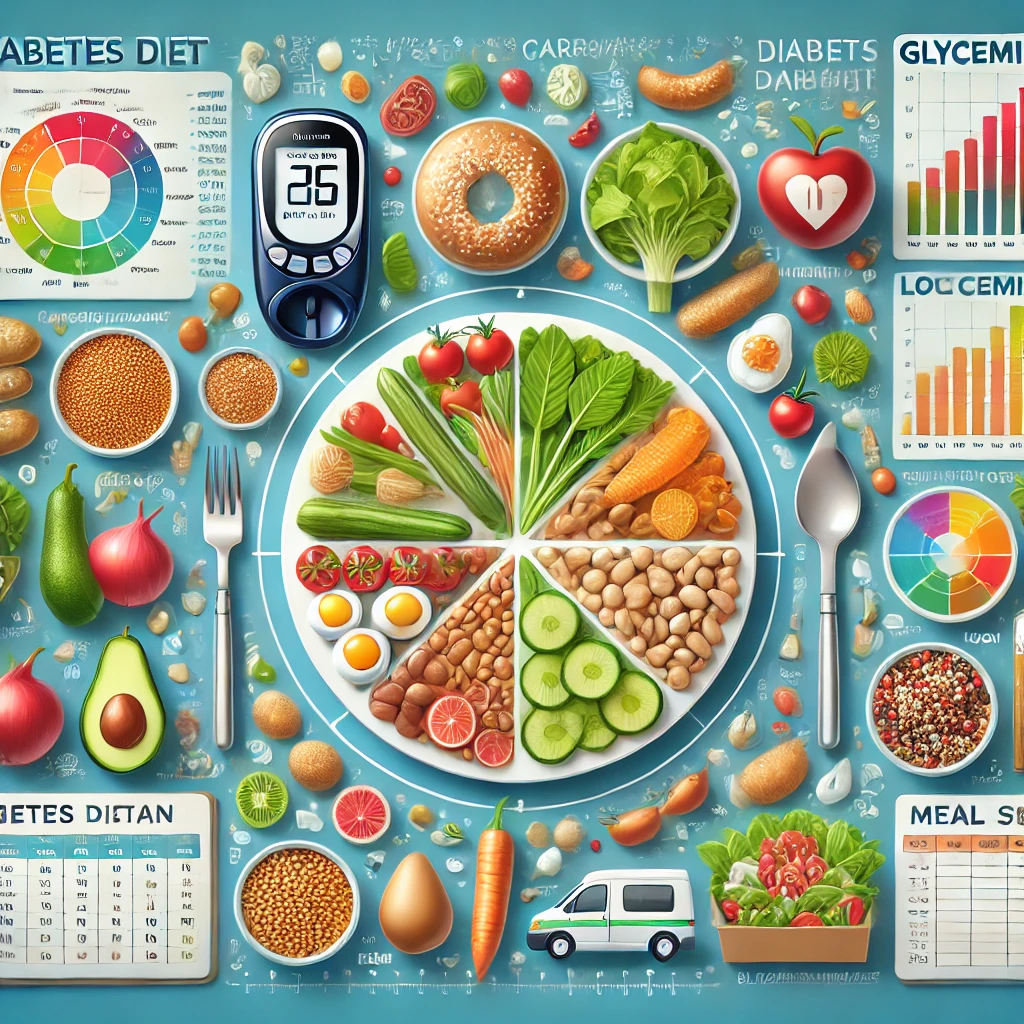Diabetes Diet Plan: How to Manage Carbs for Better Blood Sugar
Introduction
Managing diabetes requires a well-balanced diet, with a special focus on carbohydrate intake. Carbs directly affect blood sugar levels, making them a crucial component of diabetes meal planning. Understanding how to count carbs, choose the right foods, and maintain a healthy diet can significantly improve blood sugar control and overall well-being.
In this guide, we will explore the essentials of diabetes meal planning, including a 7-day diabetic meal plan, the best carbohydrate sources, and practical meal prep tips to help you maintain stable blood sugar levels.
Understanding Carbohydrates and Blood Sugar
Carbohydrates are the body’s main source of energy. However, for individuals with diabetes, not all carbs are created equal. Understanding the glycemic index (GI) and carbohydrate counting can help in making better food choices.
Glycemic Index and Diabetes Management
The glycemic index ranks foods based on how quickly they raise blood sugar levels.
- Low-GI foods (best choices): Whole grains, legumes, non-starchy vegetables, nuts, and seeds.
- Medium-GI foods: Brown rice, whole wheat bread, and certain fruits.
- High-GI foods (foods to limit): White bread, processed cereals, and sugary snacks.
Carbohydrate Counting for Diabetes
Carb counting involves tracking the number of grams of carbohydrates you consume in each meal. Here’s a general guide:
- Women: 45-60g of carbs per meal
- Men: 60-75g of carbs per meal
- Snacks: 15-30g of carbs
Using apps or food labels can help accurately measure carb intake.
Weekly Meal Plan for Diabetes
A structured diabetes diet plan helps maintain stable blood sugar levels. Below is a 7-day diabetic meal plan with balanced meals and snacks:
Monday
- Breakfast: Scrambled eggs with spinach and whole grain toast
- Lunch: Grilled salmon with quinoa and steamed broccoli
- Dinner: Chicken stir-fry with brown rice and mixed vegetables
- Snack: Greek yogurt with berries
Tuesday
- Breakfast: Oatmeal topped with nuts and chia seeds
- Lunch: Lentil soup with a side of whole grain crackers
- Dinner: Grilled turkey breast with roasted sweet potatoes
- Snack: Cottage cheese with sliced avocado
Wednesday
- Breakfast: Whole wheat pancakes with almond butter
- Lunch: Tuna salad with leafy greens and a vinaigrette dressing
- Dinner: Baked cod with a quinoa and asparagus side dish
- Snack: A handful of almonds and walnuts
Thursday
- Breakfast: Scrambled tofu with bell peppers and whole wheat toast
- Lunch: Chickpea and vegetable stir-fry with brown rice
- Dinner: Lean beef with roasted Brussels sprouts and quinoa
- Snack: Hummus with carrot and cucumber sticks
Friday
- Breakfast: Greek yogurt with flaxseeds and mixed berries
- Lunch: Grilled shrimp with a spinach and quinoa salad
- Dinner: Baked chicken with steamed kale and wild rice
- Snack: Apple slices with peanut butter
Saturday
- Breakfast: Scrambled eggs with avocado and whole grain toast
- Lunch: Turkey and spinach wrap with a side of mixed greens
- Dinner: Stir-fried tofu with broccoli and brown rice
- Snack: A handful of pumpkin seeds
Sunday
- Breakfast: Smoothie with unsweetened almond milk, banana, and chia seeds
- Lunch: Baked salmon with roasted cauliflower and quinoa
- Dinner: Grilled chicken with sautéed green beans and whole wheat pasta
- Snack: Dark chocolate and almonds
Meal Prep Tips for a Diabetes-Friendly Diet
Planning ahead can make sticking to a diabetes nutrition plan easier. Here are some useful tips:
- Plan meals in advance to ensure a balanced diet.
- Batch cook healthy meals and freeze portions for convenience.
- Use portion control to avoid overeating carbs.
- Snack smart by choosing nuts, seeds, and low-GI fruits.
FAQs
1. What is the best diet plan for diabetes?
A low-GI, high-fiber diet with lean proteins, healthy fats, and controlled carbohydrates is the best choice for diabetes management.
2. Can diabetics eat rice and bread?
Yes, but opt for brown rice, quinoa, and whole grain bread, which have a lower glycemic index than white rice or white bread.
3. How many carbs should a diabetic eat daily?
Most people with diabetes should consume about 45-60g of carbs per meal, but this may vary based on individual needs and activity levels.
4. What are some diabetes-friendly snacks?
Healthy snack options include Greek yogurt, almonds, hummus with vegetables, and cottage cheese with berries.
5. Is fruit okay for diabetics?
Yes, but focus on low-GI fruits like berries, apples, and oranges while limiting high-sugar fruits like bananas and pineapples.
Conclusion
Following a well-structured diabetes meal plan can make a significant difference in blood sugar management. By understanding carbohydrate counting, glycemic index, and balanced meal prep, you can take control of your diabetes effectively.
Start incorporating these diabetes-friendly recipes into your routine and consult a dietitian for personalized nutrition advice.
📩 Subscribe to our newsletter for more diabetes-friendly meal ideas and health tips!
